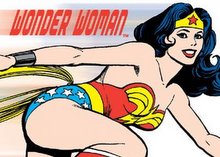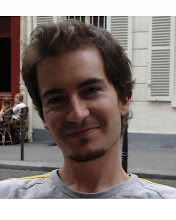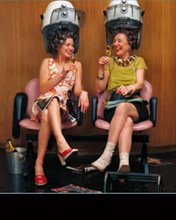Orange Island Photo Week.
Thursday June 26, 2008
Discussion transcript:
Thursday June 26, 2008
Discussion transcript:
‘SL Art in the real world‘
 Speakers Margherita Bertolucci (Margherita Balzerani) & Marco Manray (Marco Cadioli)
Speakers Margherita Bertolucci (Margherita Balzerani) & Marco Manray (Marco Cadioli)Moderator: Nick Rhodes
 Margherita Balzerani’s website
Margherita Balzerani’s websiteIntroduction.
[11:10] Nick Rhodes: Today, we are going to discuss about the relation between games and art, game as an art itself
[11:10] Nick Rhodes: the extraction of art pieces or performances made in virtual environments and shown in real life exhibitions
[11:10] Nick Rhodes: And speaking of Second Life, we will also share views about artistic creation in the metaverse.
[11:10] Nick Rhodes: Mixed reality art
[11:11] Nick Rhodes: We have the pleasure to welcome Margherita Balzerani, curator at “Le Palais de Tokyo”, Paris contemporary art museum
[11:11] Nick Rhodes: and Marco Manray, renowned SL photographer and author of the book “Io, reporter in Second Life.[11:11] Nick Rhodes: Let me introduce Margherita Balzerani


[11:11] Nick Rhodes: she is a curator and Art critic. Since 2002 she has been working at the ‘Département de l’Action Culturelle’ at the Palais de Tokyo, the site for contemporary creativity in Paris.
[11:12] Nick Rhodes: A video-game enthusiast, she is in charge of the site launch for the Palais de Tokyo in Second Life.
[11:12] Nick Rhodes: She is currently finishing a Doctorate based at the Université de Paris I Panthéon-Sorbonne and the University of Rome ‘La Sapienza’ entitled:
[11:12] Nick Rhodes: «The aesthetic challenges of video games and their influence on contemporary artistic creation».
[11:13] Nick Rhodes: Margherita Balzerani is also professor of Museography at the ‘Icart’ and of Semiotics and History of Art at the Manga School, Eurasiam. She lives and works in Paris.
[11:13] Nick Rhodes: Now Marco Manray :)
[11:13] Nick Rhodes: Marco Cadioli, artist and photographer in virtual worlds
[11:13] Nick Rhodes: aka Marco Manray started to travel and take photographs online since 2003
[11:14] Nick Rhodes: after the publication of his “Internet Landscape” Manifesto where he set up the concept of net-photography.
[11:14] Nick Rhodes: In 2005 he published “ARENAE”, a report from the war on line, shooting as “embedded” reporter in Quake III, Enemy Territory and Counter Strike.
[11:14] Nick Rhodes: In 2006 he directed the 7 minute video “Interview with the robot”, a video interview of an artificial intelligence, which was shown at Galleria Pack, Milano.
[11:14] Nick Rhodes: He has been a resident of Second Life as Marco Manray since 2005, an artist-photographer who documents the evolving of the metaverse with the stories and the images from his last project My First Second Life. 2005, right Marco?
[11:15] marco Manray: yes
[11:15] Yesterday Demain: You guys have fantastic jobs I must say :))
[11:15] Nick Rhodes: His images from Second Life have been published by international newspapers & magazines such as Liberation (Paris), El Pais (Madrid), La Repubblica (Milan), Elle Decor (Milan), Elle (Madrid), Numero Beauté (Milan), AD Architectural Digest (Milan), CasAmica Corriere della Sera (Milan), Il sole24ore (Milano).
[11:15] Nick Rhodes: His images from Second Life have been published by international newspapers & magazines such as Liberation (Paris), El Pais (Madrid), La Repubblica (Milan), Elle Decor (Milan), Elle (Madrid), Numero Beauté (Milan), AD Architectural Digest (Milan), CasAmica Corriere della Sera (Milan), Il sole24ore (Milano).
[11:15] Nick Rhodes: classy
[11:15] Nick Rhodes: He lives and works in Milan and Second Life.
[11:16] Nick Rhodes: i’ll drop exhibitions and links after the show :)
[11:16] Nick Rhodes: so let’s start with some questions :)
Current works
[11:16] Nick Rhodes: You both show art from Second Life in real life exhibitions, on a different level
Current works
[11:16] Nick Rhodes: You both show art from Second Life in real life exhibitions, on a different level
[11:16] Nick Rhodes: Marco on his own, as an individual artist, promoting his art and translating what he feels as an inside.
[11:17] Nick Rhodes: And Margherita as an art director, choosing artists to be shown in major events about arts or games.
[11:17] Nick Rhodes: Can you both give us inputs about your work ?
[11:17] Yesterday Demain: (Again… If you have questions for our speakers, please IM Natty Foggarty or me) [11:17] Margherita Bertolucci: Florence “Rinascimento Virtuale” at Natural History Museum opening 21 october 2008, an event organized by Mario Gerosa and I am an inviting curator.
[11:17] Margherita Bertolucci: Florence “Rinascimento Virtuale” at Natural History Museum opening 21 october 2008, an event organized by Mario Gerosa and I am an inviting curator.
 [11:17] Margherita Bertolucci: Florence “Rinascimento Virtuale” at Natural History Museum opening 21 october 2008, an event organized by Mario Gerosa and I am an inviting curator.
[11:17] Margherita Bertolucci: Florence “Rinascimento Virtuale” at Natural History Museum opening 21 october 2008, an event organized by Mario Gerosa and I am an inviting curator.[11:18] Margherita Bertolucci: - in Paris Reality Festival november 2008, the first festival around virtual worlds behind me an exemple of a projet by Gregoire Diehl, an architect. the name of the project is MAP.
[11:18] Margherita Bertolucci: an exhibition in the festival of video games in september 2008 in Paris
[11:19] Margherita Bertolucci: a project, “Traverses, livre voyageur”, artistic director of their next book, with Karen Guillorel
[11:19] Nick Rhodes: aka Nout Eales :)
[11:20] Yesterday Demain: who’s here tonight :)
[11:20] Nick Rhodes: Marco can you speak about your rl exhibition and the work that can be seen on the side of the plaza?
[11:21] marco Manray: ok thank you nick and to the public
[11:21] marco Manray: I show my artworks in rl
[11:21] marco Manray: and this is an important part of the poetic of my work
[11:22] marco Manray: bring the life of the net and virtual worlds out of here
[11:22] marco Manray: in rl
[11:22] marco Manray: make a bridge between inside and outside
[11:22] marco Manray: a hole in the net
[11:22] Nick Rhodes: it has something to do with fooling our eyes, and make us think it could has been taken in real life.
[11:23] marco Manray: may be
[11:23] Nick Rhodes: How do visitors in real life react to it, do they think they’re real life photos?
11:23] marco Manray: these photos have a metaphorical meaning
[11:23] marco Manray: This is the beginning of virtual worlds, the empty land of second life untouched by human beings.
[11:23] marco Manray: People in SL dont recognize sl in these photos, people in real life don’t recognize sl in them.[11:23] marco Manray: So it is a double cheat. I like the effect of “spaesamento” “depaysé” they give to the observer.
[11:23] marco Manray: I like to reproduce the rock, so heavy and material, in a world without atoms.
[11:24] Nick Rhodes: Were you already thinking about showing them in real life when you took them?
[11:25] marco Manray: Yes I thought about showing them in rl. That affects the resolution and the size you choose.[11:25] marco Manray: I print them with fine art photography standards, lambda prints on aluminium, 70×100 cm.[11:25] marco Manray: But I roam to find the place, I miss myself in the metaverse.
[11:25] marco Manray: My approach is the same as if I shoot in RL, but here I can fly and move the camera in a more free way.
Games as participatory art.
Games as participatory art.
 [11:26] Nick Rhodes: Margherita, you say your religion is video games :) and you give numerous conferences, even working on a thesis about video game as an art form.
[11:26] Nick Rhodes: Margherita, you say your religion is video games :) and you give numerous conferences, even working on a thesis about video game as an art form.[11:26] Nick Rhodes: You also speak about game culture, can you tell us more about this?
 [11:26] Margherita Bertolucci: In the era of cyber culture and collective intelligence, video game establishes itself more and more nearby the artistic disciplines historically settled.
[11:26] Margherita Bertolucci: In the era of cyber culture and collective intelligence, video game establishes itself more and more nearby the artistic disciplines historically settled.[11:27] Margherita Bertolucci: Its aesthetics and its way of revisiting the real reveal a new “formal representation” and an increasing number of contemporary artists use it as an expression form.
[11:27] Margherita Bertolucci: The spatial development of video games is comparable to contemporary installations, it presents itself as a distinctive space recreated into a public or a domestic dimension.
[11:28] Margherita Bertolucci: Video games, like installations, intensify the feeling of displacement or ubiquity, that any kind of show may provide.
[11:30] Nick Rhodes: we will post transcript for those who dont follow :)
[11:30] Nick Rhodes: Margherita, you once told me that you sometimes got fed up to see art pieces
Nick Rhodes: sometimes hard to define, about games, around games,
[11:30] Nick Rhodes: but not considering game as an art itself ? can you explain this ?
[11:30] Margherita Bertolucci: The video game represents a post-modern form where contemporary artists may express the idea of “Gesamtkunstwerk” evoked by Richard Wagner (1813- 1883) in the second half of the XIX century with his theory of the “complete art work piece”.
[11:31] Nick Rhodes: the “complete art work piece”.
[11:31] Nick Rhodes: interesting
[11:31] Margherita Bertolucci: The installations using video games mechanism make us pass from the idea of “relational aesthetics” introduced by Nicolas Bourriaud
[11:31] Margherita Bertolucci: to ‘participative aesthetics’ where the audience takes the place of the protagonist.[11:31] Yesterday Demain: We become part of the art , right?
[11:31] Nick Rhodes: the protagonist ? like in sl^^
[11:32] Margherita Bertolucci: yes!
[11:32] Margherita Bertolucci: We are witnessing a turning point in the way of experimenting life which consists in interrogating the body within space and time in synaesthesia.
[11:32] Nick Rhodes: synaesthesia is having several senses wake at the same time
[11:33] Margherita Bertolucci: Contemporary artists seem indisputably to make their own Duchamp’s words: “the viewers are the ones who make the painting”.
Nick Rhodes: sounds like web 2.0 :)
[11:33] Yesterday Demain: Same could apply to photography?
[11:33] marco Manray: user created art
[11:33] Nick Rhodes: yes :)
[11:33] Margherita Bertolucci: The artwork remains unfinished until the spectator has received it, the viewer turns into an actor in a spectacular dynamics
[11:34] Margherita Bertolucci: and his relation to the work of art goes beyond a simple passive contemplation.[11:35] Nick Rhodes: If each resident is potentially both user and creator, what creative possibilities could there be.
 [11:35] Margherita Bertolucci: Creator or demiurge of oneself, one’s environment or life context, each resident, via their avatars, is both actor and spectator at the same time.
[11:35] Margherita Bertolucci: Creator or demiurge of oneself, one’s environment or life context, each resident, via their avatars, is both actor and spectator at the same time.[11:36] Nick Rhodes: your world, your imagination?
[11:36] Yesterday Demain: Does the artist still remain the creator then?
[11:36] Margherita Bertolucci: yes this is the idea of build youself and around you!
[11:36] Margherita Bertolucci: But is the creative potential that Second Life offers its users, the chance of an experience that takes into account
[11:37] Margherita Bertolucci: immaterialism, immortality and ubiquity, is this sufficiently exploited at the present time.
[11:37] marco Manray: yes this is a central point
[11:37] Margherita Bertolucci: Faced with the constraints of our real world, will we be able to build with virtual architecture and create an immaterial environment
[11:37] marco Manray: because all we see around may be a sort of art creation
[11:38] Margherita Bertolucci: that would take into account weightlessness, the immaterial, the invisible, the ephemeral, synaesthesia, empathy, emotions, desires, humidity, sound and intimacy.
[11:38] marco Manray: for that I looked for empty lands
11:38] marco Manray: without buildings
[11:38] marco Manray: just the grid
[11:38] Margherita Bertolucci: yes I agree
Virtual art and reality.
 [11:38] Nick Rhodes: Are we heading towards the virtualization of artistic creation and the artist?
[11:38] Nick Rhodes: Are we heading towards the virtualization of artistic creation and the artist?[11:39] Margherita Bertolucci: If this open platform could provide artists with the opportunity of overcoming our real-life restrictions,
[11:39] Margherita Bertolucci: why are we systematically faced with a reproduction that is an identical replica of our first life
[11:40] Nick Rhodes: You certainly have been in contact with various creation form in Second Life, what do you think of it?
[11:40] Nick Rhodes: Margherita?
[11:40] Margherita Bertolucci: The increasing number of exhibitions and Art venues in Second Life seems to support the idea of using a virtual 3D universe for artistic creation
[11:40] marco Manray: there is a sense of continuity, without cuts between rl and sl
[11:41] Margherita Bertolucci: But if for the time being, the art now exhibited in Second Life is too often presented as a formal ‘mimesis’ of reality,
[11:41] Margherita Bertolucci: this trend indicates that, rather than determining to be creative themselves, the residents are happy to produce cloned pixel images of their present reality
[11:41] Nick Rhodes: Marco any view about the ever cloning of reality ?
[11:42] Nick Rhodes: do you think we can break this…
[11:42] marco Manray: I think that it is not a pure cloning
[11:42] marco Manray: as in rl
[11:42] marco Manray: everyone has the same tools to create
[11:42] marco Manray: a picture for exemple
[11:43] marco Manray: but it is more important what you chose to see, to tell
[11:43] marco Manray: my last pictures look like real
[11:43] marco Manray: but this is not important for me
[11:44] marco Manray: reproduce reality is not the focus of my projects
[11:44] Margherita Bertolucci: If Second Life provides the opportunity for an experimental context,
[11:44] marco Manray: but with this sense of reality I pose the question about what we are building around us, that kind of landscape we draw for ourself
[11:45] Margherita Bertolucci: there are still very few artists who seem interested in adapting this tool or quite simply in pushing back the boundaries.
[11:45] Margherita Bertolucci: Like you Marco
[11:46] Yesterday Demain: SL is a very social environment… do you believe this has effects on artistic creation? Is this ‘Social Art’ ?
[11:46] Yesterday Demain: SL is a very social environment… do you believe this has effects on artistic creation? Is this ‘Social Art’ ?
[11:46] Nick Rhodes: Marco ?
[11:47] marco Manray: there are many collaboration between artist in sl
[11:47] marco Manray: some one work in group, like many performer
[11:47] Margherita Bertolucci: yes because it is like a geant WIKI
[11:47] marco Manray: I don’t think about a social art
[11:47] Margherita Bertolucci: collaborative, interactive
[11:48] marco Manray: is art for everyone, not for the inside network
[11:48] Nick Rhodes: O i see :)
[11:48] Margherita Bertolucci: sure I agree
[11:49] Yesterday Demain: But we’re all part of this network…
[11:49] marco Manray: sometimes is interactive, like in the wonderful experiments of keystone bouchard
[11:49] Nick Rhodes: what is this Marco ?
[11:50] Nick Rhodes: i see like a collaborative tool, but for artists ?
[11:50] marco Manray: all intercative audio sculpture
[11:50] marco Manray: or the unsung song exhibited at odyssey
[11:50] Nick Rhodes: is it inside second life ?
[11:51] marco Manray: yes
[11:51] marco Manray: let me remember the artist’s name
[11:51] Nick Rhodes: let me ask you a last question, before we take questions from the audience
Defining digital arts
[11:52] Nick Rhodes: Margherita and Marco, how do you think digital art will age?
Defining digital arts
[11:52] Nick Rhodes: Margherita and Marco, how do you think digital art will age?
11:52] Nick Rhodes: i mean is it an art that takes place in its time and then dies,
[11:52] Nick Rhodes: does it retain value (artistic and commercial) eventually thoughtout time?
[11:52] Margherita Bertolucci: I believe digital art - as any art - are timeless, but the advantage of digital art is in its immateriality and dematerialization :)

[11:53] Nick Rhodes: fast answer ;P
[11:53] marco Manray: good question for my work
[11:53] marco Manray: it is about memories
[11:53] Margherita Bertolucci: yes I know my subject ;)
[11:53] marco Manray: memories of the present
11:54] marco Manray: so I wonder how people will look at this picture in 20 years
11:54] Nick Rhodes: yes interesting and also about ubiquity, so about the space 2
[11:54] Nick Rhodes: not only time
[11:54] marco Manray: yes
[11:54] Nick Rhodes: nice :) I got some audience question incoming :)
[11:55] Nick Rhodes: …computing…
[11:55] Yesterday Demain: I have a question from Kali Meads : what do you think about the social constructionism of art in Second Life… how language informs art, and art informs language…
[11:55] Yesterday Demain: I have a question from Kali Meads : what do you think about the social constructionism of art in Second Life… how language informs art, and art informs language…
[11:56] Yesterday Demain: (when in the end it’s all binary code)
[11:55] marco Manray: margherita…
[11:57] Margherita Bertolucci: mmmm I think that is the artist who creates the language
[11:58] Kali Meads: but the concept of digital art is that its a binary code translated ino a human emotion at times[11:58] Kali Meads: i just find the concept interesting
[11:59] Kali Meads: and in turn the human translaion of the 10101010101
[11:59] Kali Meads: in turns affects the language within sl communities and other VW
[11:59] marco Manray: there are many kind of digital arts
[11:59] Margherita Bertolucci: yes but the interest is not in the tools but about emotions
[11:59] marco Manray: and maybe that all art is becoming digital with the development of new tools
[11:59] Kali Meads: i was just wondering about your feelings about this concept
[12:00] marco Manray: I think that we will go forward this concept of digital art
[12:00] marco Manray: or software art
[12:00] marco Manray: as in code performer, like gazira babeli
[12:00] marco Manray: sometimes the code is at the center of the art project
[12:01] marco Manray: sometimes digital equipments are just tools
[12:01] marco Manray: I am not sure if my art is still digital art
[12:01] Margherita Bertolucci: For me the feeling about digital art not change but artistic possibilities
[12:01] marco Manray: or it is story telling, create memories, witness
[12:02] Mescaline Tammas: Is it frustrating to not be able to ‘touch’ your art?
[12:02] Margherita Bertolucci: sure Marco the interest is the esthetical feeling
[12:02] marco Manray: digital art must go out of his boundary because all is becoming digital
[12:02] Nick Rhodes: it looks like art is now travelling freely through both worlds… like your art Marco :) it is about breaking the borders may be ?
12:02] marco Manray: our relation are mediated by computer
[12:03] marco Manray: the landscape itself in witch we are going to live is changing
[12:04] marco Manray: where our avi will put their feet in a few years?
[12:04] Margherita Bertolucci: When you are in front of a picture you can’t touch but you can have the feeling of the meaning painting also: memories, lost, ect
[12:04] marco Manray: I am exploring other part of the metaverse in these days
[12:05] Nick Rhodes: which part ?
[12:05] Nick Rhodes feels sneaky
[12:05] marco Manray: very difficoult to move with a chinese interface!! lol
[12:05] Kali Meads: coughs*blue mars *cough
[12:05] Nick Rhodes: lol
[12:05] marco Manray: I feel lost in the metaverse
[12:05] Nick Rhodes: blue mars, are you in the beta ?
[12:06] marco Manray: no other worlds
[12:06] Margherita Bertolucci: me too I’m lost in metaverse
[12:06] Nick Rhodes: like hipihi
12:06] marco Manray: and I telll to the people I meet: “I come from Second Life”, not ” I come from Milano”
[12:07] marco Manray: and they understand me
Audience questions
[12:06] Yesterday Demain: A question from Moya Janus: Can there still be an avant-garde in an ubiquitous system?[12:07] Nick Rhodes: very conceptual question, love it
Audience questions
[12:06] Yesterday Demain: A question from Moya Janus: Can there still be an avant-garde in an ubiquitous system?[12:07] Nick Rhodes: very conceptual question, love it
[12:07] marco Manray: this is for margherita ;-)
[12:08] Margherita Bertolucci: yes I think that the avant-garde of space it’s power of teleportation
[12:10] marco Manray: there is a avant-garde connected by the net, a community around the world that work like a classic avant-garde
[12:11] marco Manray: their headquarters are Ning community, blogs, small indipendent magazine
[12:11] Margherita Bertolucci: the community of future is in the smart masses
[12:12] Yesterday Demain: A question from tarashot Sass: Since our cultural heritage marks our progress through time, what is the Museum’s role in preserving digital art and how will it do so in the future?
[12:12] Yesterday Demain: A question from tarashot Sass: Since our cultural heritage marks our progress through time, what is the Museum’s role in preserving digital art and how will it do so in the future?
[12:12] Yesterday Demain: Great question, btw…
[12:13] Margherita Bertolucci: It’is the idea of Andre Malreaux of an imaginary Museum
[12:14] Margherita Bertolucci: where all artworks are digitalized and persistent
[12:14] Yesterday Demain: There are many institutions preserving paintings, film, but who’s doing something for digital arts?
[12:14] Yesterday Demain: Does anyone know of any examples?
[12:14] tarashot Sass: i think Moma SF is
[12:15] tarashot Sass: it reminds me of the work of Sol Lewitt
[12:15] Margherita Bertolucci: The BNF in France
[12:15] Margherita Bertolucci: The Centre Pompidou
[12:15] tarashot Sass: many people have bought Sol Lewitt pieces
[12:15] tarashot Sass: they are not tangible works of art when purchased
[12:15] tarashot Sass: however the pieces are only plans and must be executed
[12:16] Nick Rhodes: in museums you can’t touch art ;P
[12:16] Margherita Bertolucci: but you can feel it
[12:16] Yesterday Demain: Hardware and software will keep evolving… that’s another issue…
[12:17] tarashot Sass: right…and i think it will still be the role of the museum to preserve it
[12:17] marco Manray: a lot of software art will not run anymore
[12:17] Yesterday Demain: The web, maybe?
[12:17] Margherita Bertolucci: Yes for this reason I proposed of Palais de Tokyo to build a “place” in SL
[12:18] marco Manray: to collect art margherita
[12:18] Margherita Bertolucci: to produced and preserved
[12:19] marco Manray: production is an intersting issue too
[12:20] marco Manray: an important role for a museum
[12:20] Yesterday Demain: A question from Aron Easterman: Does anyone have an opinion about Walter Benjamin’s idea about “Aura” in the digital age?
[12:20] Yesterday Demain: A question from Aron Easterman: Does anyone have an opinion about Walter Benjamin’s idea about “Aura” in the digital age?
[12:20] Margherita Bertolucci: Walter Benjamin says that every piece of art can be reproduced
12:20] Margherita Bertolucci: nowadays
[12:20] Margherita Bertolucci: is it right, is it not, it is just the future
[12:21] Margherita Bertolucci: the act of creation makes the art piece
[12:21] Margherita Bertolucci: not the number of pieces
[12:21] Kali Meads: coughs *andy warhol *coughs
[12:22] Nick Rhodes: ok this was the last question, we got a great class with Callipygian right after :)
[12:22] Nick Rhodes: i want to thanks the speakers :)
[12:22] Nick Rhodes: for having been with us :)
[12:22] marco Manray: YW
[12:22] Nick Rhodes: and the great audience we had :)
[12:22] marco Manray: and thanks to you all :-)
[12:22] Margherita Bertolucci: thanks all
[12:22] Kali Meads: ty very much
[12:22] Kali Meads claps
[12:23] Fab Outlander: Thank you all
[12:23] Margherita Bertolucci: for qualitatives questions :)
[12:23] marco Manray: :-)


























